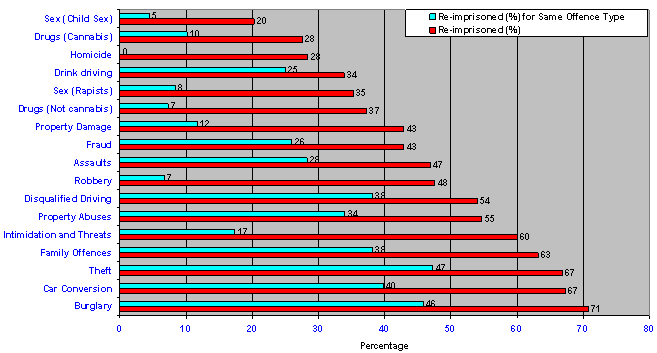Reimprisonment rates by new offence type
It is generally accepted, based on a wide range of studies that most offenders do not “specialise” in any one type of offence: that is, the vast majority of persistent offenders have criminal histories featuring a sequence of convictions for offences across the criminal code. For example, many “violent offenders” have histories in which convictions for violence are interspersed with significant numbers of convictions for traffic offences, property offences, drug use, and so on. Tendencies towards specialisation do occur in some instances however.
The graph below reports on the reconviction data for the current sample in a different manner to all of the other data in this report. Instead of counting any re-imprisonment during the follow-up period (where those re-imprisoned once and those re-imprisoned five times would each be counted just once), the graph gives the re-imprisonment rates for the same class of offence at any time during the follow-up period.
The figures produced in this way indicate that only very small proportions of released robbery, drugs or sex offenders are re-imprisoned within 48 months for the same type of offence. There were no recorded instances of homicide offenders being re-imprisoned for another homicide offence within 48 months. However, once again a very different pattern emerges for the dishonesty offenders: fully 46 percent of released burglars were re-imprisoned at least once specifically for burglary, and a similar proportion of thieves for theft.
Disqualified drivers also appear to be highly recidivistic with respect to this type of offending although, as noted above, these offenders tend to return to prison with multiple convictions for a range of different offence types. Also of concern is the relatively high proportion of “family offenders” (mainly those convicted of domestic violence) who go on to commit further such offences.
Very low rates of reconviction for similar offences were recorded for sex offenders. As alluded to previously however, this cannot necessarily be interpreted as signifying that these offenders seldom go on to commit further such offences. Sex offences against children, in particular, are subject to very low reporting rates. Even when a sex offence is resolved by the police, rates of successful convictions in court are also relatively low. It is also the case that, with convicted sex offences, the length of time that tends to elapse, between the actual offence being committed and the offender’s ultimate sentencing on that charge, can be several years. Thus the validity of this type of analysis will be improved when reconvictions for sex offenders have been tracked over longer periods of time.
Graph 9: Re-imprisonment rate by most serious offence type, and new offence type


